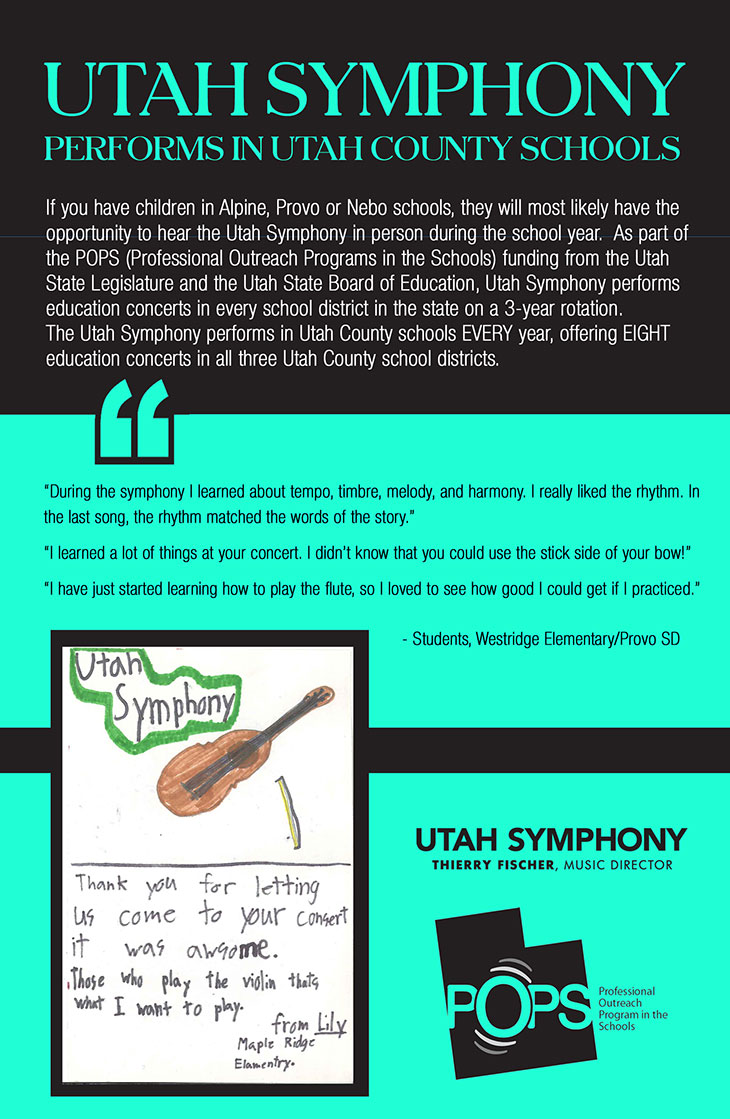Utah Symphony
History of the Music
History of the Music

By Jeff Counts
Overture to Egmont, op. 84
Duration: 9 minutes.
THE COMPOSER– LUDWIG VAN BEETHOVEN (1770-1827) – With Vienna under French occupation during much of 1809, Beethoven was forced into an uncomfortable seclusion. Though he chose to stay behind, many of the city's elite had fled, including the court. Among them was Beethoven's patron, friend and student Archduke Rudolf. The composer wrote most of the 5th Piano Concerto during his time alone and dedicated it to his absent compatriot. One interesting facet of the momentary French rule was the loosening of certain censorship laws, which gave several previously banned plays a new life in the city.
THE HISTORY– Near the end of that troubling year, Beethoven received a commission to write incidental music for a theatre production of Egmont, one of the plays reinstated by the occupiers. This must have come as a refreshing diversion from the composer's sadness and solitude. Not only did the opportunity provide a chance to deeply connect with the words of his most favored writer Goethe, the subject of the drama was also particularly poignant for Beethoven. In the play, Count Egmont is a Dutch resistance fighter bent on the liberation of his country from Spanish occupation. He dies heroically after making his stand in a moment that Goethe believed worthy of a "symphony of victory." It is impossible not to draw a parallel between the character of the Duke of Alva and the real-life "Emperor" of France. Beethoven had long since lost his admiration for Napoleon and the bombardment of Vienna, though quite mild in comparison to what happened in Spain, would certainly have confirmed his worst fears about the man. Goethe's play, and the honor of providing it with some suitably powerful incidental music, was perfect medicine for the composer after such dark, lonely months. The score of Egmont was completed in 1810 and performed in its entirety that June. Only the overture still receives frequent performance attention as a stand-alone concert piece. Had Beethoven chosen to create a follow-up to Fidelio, one wonders what kind of opera might have grown out of the apparent increase in theatrical maturity on display in Egmont. The overture is a wonderfully intricate microcosm, one that successfully samples all the coming drama of the story.
THE WORLD– Elsewhere in 1810, Argentina began a chain-reaction in South America by claiming independence from Spain, the first Oktoberfest was held in Bavaria and Lord Byron made his famous swim across the Hellespont in Turkey.
THE CONNECTION– The Egmont Overture is programmed fairly often by the Utah Symphony but has not appeared on the Masterworks Series since October 2015. Thierry Fischer conducted.
Concerto in D Major for Violin, op. 77
Duration: 38 minutes in three movements.
THE COMPOSER– JOHANNES BRAHMS (1833-1897) – In the middle years of the 1870s, Brahms was forced to contend with something his dogged humility may have been averse to – fame. His first two symphonies, finally written after decades of doubt, were actively out in the world confirming him as both Beethoven's successor and a conservative foil to Wagner and the other progressives. This success gave Brahms the courage to stare down another of his persistent ghosts, this one of his own design. It was time to write another concerto.
THE HISTORY– Not since 1859 and the disastrous launch of his 1st Piano Concerto had Brahms given serious thought to composing another, for any instrument. It was a friendship, a long and devoted one, that eventually brought him back around. Brahms and violin virtuoso Josef Joachim had been friends since 1853, and the latter had been a great help during the construction and trials of the piano concerto. Joachim must have been thrilled then when Brahms told him in 1878 that he had a few nascent "violin passages" to share. Joachim fully expected a highly collaborative process to ensue, much like the one they established back in 1857 and 1858, and he got one. Whenever they could not meet in person, letters and manuscript morsels flew back and forth between the two comrades. It wasn't always enjoyable. Brahms was often resistant and occasionally dismissive of Joachim's expert corrections. But both men wanted the piece to be special, worthy of another orbit around Beethoven's star. Joachim was enthusiastic about the possibility of New Year's Day premiere in 1879, but Brahms felt unready to meet so ambitious a deadline. He did, in the end, but that Leipzig performance felt a little thrown together, and the friends fretted until the Vienna concerts two weeks later where they could finally enjoy the response they had hoped for. The symphonic nature of the work would continue to fuel its detractors though, Pablo Sarasate notable among them, and the concerto did not always make a big splash in its travels after Vienna. This is hard to fathom, given the work's current standing (with Beethoven and Mendelssohn) as one of the three unbreakable pillars of 19th century violin mastery. Posterity often makes better arguments than audiences, it seems, and Brahms's stern masterpiece would simply have to wait for its due.
THE WORLD– Elsewhere in 1877, Oglala Lakota leader Crazy Horse was killed by a soldier while in confinement in Nebraska, the first Championships at Wimbledon were held and the Martian moons Phobos and Deimos were discovered.
THE CONNECTION– Brahms' Violin Concerto is a popular work on Utah Symphony Masterworks seasons. The most recent performance was in February 2019 under the baton of Mario Venzago with Stefan Jackiw as soloist.
